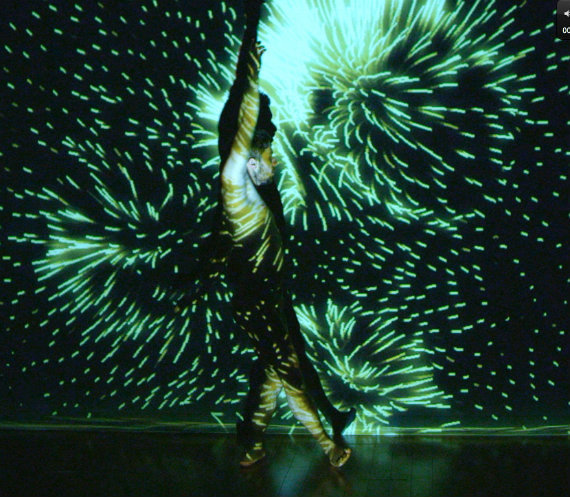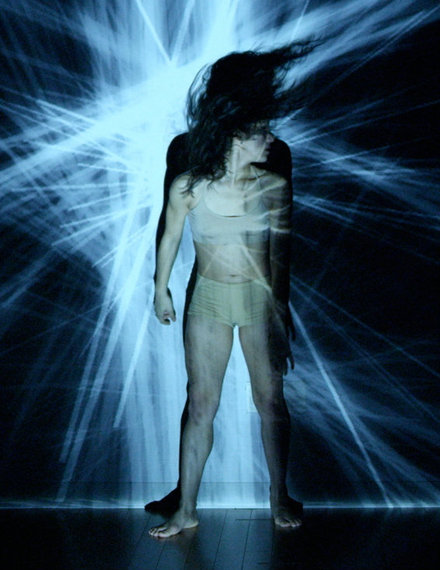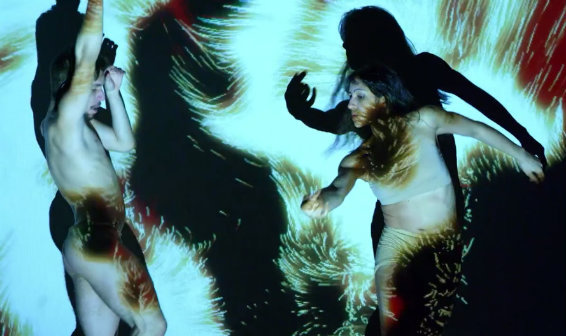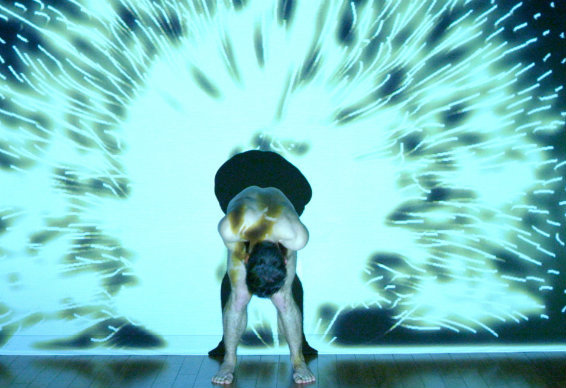The ethereal-looking dancer gracefully stretches her arm toward the sky. A beam of bright light shoots from her fingertips like a thunderbolt. Her partner crouches in a fetal-like position. When he leaps from the ground, rays of green light burst behind him. As he stands facing us, the rays emanate from his head and limbs recalling iconic religious imagery: a modern-day "Archangel Gabriel" appears to have come to life. Now his partner reaches toward him dramatically, arms outstretched , as if begging for an embrace.
He moves toward her, then suddenly backs away. "Un baile entre gato y raton" : a cat and mouse dance? Perhaps. Circles of light envelop the dancers in evolving bubbles of color that seem to float against a blazing neon backdrop. Then suddenly a blinding flash. A universe on fire? Not to worry.The dancers seem to actually push back the blinding light, emerging unscathed. But for how long? A moment later the neon explosion seems to give way to tiny amoebas of light that flicker behind the dancers and build impressively. They are like an army of twinkling lights in an indigo sky. Or is it a Milky Way just beyond our reach? The dazzling effect is mesmerizing, even haunting.
The astonishingly limber and expressive dancers, Jesus Olivera and Soleil Acevedo, are part of New York City's Eryc Taylor's Dance Company. And now ETD is on the cutting edge of an exciting digital technology called "projection mapping." Brooklyn-based digital artist Jason Levine (working with ETD's Artistic Director and choreographer Eryc Taylor) has taken the technology to the next level. The program is called "skeleton tracking." It follows the motion of dancers and uses data stored on a laptop to generate arresting interactive graphics. Levine uses a tiny camera to track the dancers' bodies. "This little camera actually tells me at every moment in 3D space where the dancers' heads are, their shoulders, their hands, elbows knees and feet," he says. "Using this I can extend the joints to create abstract graphics that are intimately linked with their movements and positions.
The use of light technology in dance has long fascinated ETD choreographer Eryc Taylor. Taylor received a Masters of Fine Arts degree from NYU's Tisch School of the Arts and studied at London's Contemporary School of Dance and the Centre de Danse du Marais in Paris. He's also performed works by Merce Cunningham, Paul Taylor and Milton Meyers among others. While working as a dancer in the mid 1990's with a company called Group Motion in Philadelphia, the company's director, Manfred Fischbeck, used video projection for many of the works in which Taylor was featured. But the technology wasn't interactive. Taylor began collaborating with Levine in 2011 when Levine's creations using digital/art technology impressed him. Now Taylor hopes to develop an evening length work in New York City and a national and international tour using Levine's "skeletal tracking" technology. But first Taylor must find funding for a residency that will expand the use of projection mapping. He says the objective is to create a new and vital original work. "We have only scratched the surface of possibility with the astonishing outcome of Jason's video technology."
Projection mapping is being used by more and more dance companies to create a feast for the eyes. In October, 2012, The Interactive design company Ultra Combos teamed up with the Taiwanese dance Company Anarchy Dance in an innovative visual performance entitled "Seventh Sense." It used projection mapping to allow both the dancers and the audience's movements to be part of the action. Every person in the room, whether performer or audience member, contributed to changes in the visual spectrum. That spectrum varied from soft ripples to jagged lines of light that recalled earthquake faults. "Dance merged with technology has evolved inspired by dance artists past and present" according to Emily Macel in a December, 2007 article for Dance Magazine entitled "idance." She refers to dance artists such as "Loie Fuller and Alwin Nikolais as well as current choreographers Merce Cunningham and Bill T. Jones, as legends who pioneered metaphor using lights, cameras and computers." Indeed Ms. Macel writes that as far back as 1989, choreographer Dawn Stoppiello and composer/media artist Mark Coniglio began working on a wireless movement sensing outfit that transmitted a dancer's positions to a computer. "The information can be used to control video, audio, lighting and set," she writes. Macel reports that in 1999, Coniglio developed "Isadora" (named after the legendary pioneer of dance) as an interactive graphic program with a focus on the real-time manipulation of digital video. "Isadora" technology has been embraced by a growing number of dance companies around the world.
But the "skeletal tracking" technology Levine is developing for Eryc Taylor Dance takes it up a notch. "This is not an application that's general purpose like Isadora, any dance company can use it," emphasizes Levine. "What I did for ETD is that I wrote my own programming from scratch. It's really custom-made to Eryc's creative vision," he adds. "We're using the "Kinect" which is a Microsoft video game controller." Levine explains that the controller was altered specifically to track dance movements. "The Kinect gives you a 3D image of the dancers which we can then use to project visuals exactly on them."
At a recent workshop at New York City's Drama League, the startling visuals generated by Levine drew gasps from the invited audience of dance aficionados, friends and journalists. The dancers appeared to be dancing in an alternate universe of blinding light. The imagery made us feel as if we were being transported to a place we had never been before. At times it felt as if we (along with the dancers) were part of the movie "Gravity" -- hurled into a universe or galaxy both beautiful and unsettling at the same time. We were no longer just watching dancers perform. We were part of the action ourselves. Dancer Jesus Olivera says this interaction between the dancers and the audience is critical. "We are giving the questions to the audience, and they are giving us the answers with their energy," he says. That energy translates into an interactive performance that breaks the bounds of conventional dance. "We're tracking 300 points on every dancer's body and we're watching frame to frame how they move," says Levine. "I want the the computer to know for a specific dancer when they are in the spectrum of what they do and adjust accordingly," says Levine. "If a dancer takes a chance, the whole program changes and goes off course and creates a whole new visual.
Levine says the connection between the dancers and the projections can range from subtle to intense. "My mission with combining dance with technology is that dance lead the technology," he continues. "To develop this work we'll need a residency in a space where we can set up the projector, the camera and where the dancers, the creative director and myself can work together on developing the connection between the dancers," he says. Taylor is excited about the prospects of the "skeletal tracking" technology for his eight year old not-for-profit dance company. "The program will basically understand the personality and the movement qualities of each dancer individually, " Taylor says. "My movement and choreography varies from very technical ballet vocabulary to post-modern styles of dance but it's structured improvisation. The computer program will know the personality of each dancer and if they do something different, the computer will adapt to that and the graphics will change."
With the light technology Taylor hopes to create a piece that allows the dancers to explore different "worlds." In the "discovery" phase, particles of light will evolve into larger circles as the dancers explore the projections. In the "creation and destruction" world the dancers will be accompanied by projections depicting air, water, fire and earth. In the third phase Taylor calls an "alternate universe" the dancers will explore the weightlessness of zero gravity as well as what is is like to live in today's modern "electronic" world. An important component of Taylor's vision are the electronic musical compositions of renown digital artist and composer Freida Abtan. "Freida works with samples of both musical and non-musical objects that she records herself and then manipulates, often beyond recognition," Taylor says She alters music using "digital processing." Abtan uses techniques derived from "musique concrete" and through successive layers of processing. The effect is other-worldly, eerie and ultimately magical. It's music for the New Age and beyond. Taylor says Abtan has agreed to compose an original electronic score for ETD. "Each track and layer of music will be sound reactive to the projections," Taylor says. The music will enhance the light projections and influence the dancers' movements and storyline.
Depending on the audience member, one might see the light projections as signaling a world in chaos. The slicing beams of light triggered what appear to be explosions and destruction. The chaotic scene recalled a theme first explored cinematically by Italian director Lina Wertmuller. She was nominated for an Academy Award for directing the 1976 film "Seven Beauties." In interviews Wertmuller spoke of exploring the concept of man fighting "il disordine del mondo" (the disarray of the world). She explained it as the human desire to impose order in a world and universe that cannot be controlled. As I watched a sneak peek performance of ETD's "skeleton tracking" technology, it seemed as if the dancers were exploring in dance what Ms. Wertmuller sought to explore in film. The lights signify a universe appearing to come apart. The dancers represent humanity seeking to bring order to this world in disarray. No matter how strongly the dancers attempt to dominate the explosions of light, the light always seems to fight back. There are no clear-cut winners. This constant tension, creates a visually exciting language between the dancers. And for the audience, a tantalizing mystery. Is it a love story or a story of a world in "disordine"? In Taylor's opinion, it's entirely up to you.
"When there are two dancers on stage, there are moments of light, there are moments of passion, there are moments of tension," Taylor says." It's more of a narrative rather than a love story. It's up for interpretation." With proper funding Taylor dreams of a world tour using the light technology in "site-specific" locations. "It could be an abandoned building in Berlin or a factory in Singapore or a castle in Scotland, a church in France or a warehouse in Brooklyn" he says. "The texture of those different site-specific sites will change the quality of the projections."
When I ask dancer Jesus Olivera about what I interpreted as a "cat and mouse" game amid the lights between himself and dancer Soleil Acevedo, he grins broadly. Jesus reverts to his native Spanish and tells me "salio asi." Translation: It just came out that way. "It was a just a moment on the set with our moves that we went to that place we could not control. It was in our mind in a very deep place," Olivera says. "The play between the lights, the music, the energy can touch on a lot of different stories," he adds. And so for the audience the light technology offers an ever-changing sensory experience. One leaves a performance invigorated and touched in an almost spiritual way. Acevedo agrees and says dancing in light makes her feel vulnerable and almost "literally naked." Taylor believes the projections of light imbue the dancers with a purpose beyond just movement. "They can throw energy to each other and the person will throw a different energy back," he says. "It's a constant exchange of energy and emotion." And it's that energy and emotion that can move and exhilarate an audience. Advancements in light technology open up a whole new world of endless possibilities in dance -- possibilities that not only entertain us -- but enlighten us as well.
On April 22, ETD will present "Emergence" -- an evening of dance that will feature original works choreographed by the three recipients of 2013 ETD grants for aspiring choreographers. There will also be a sneak peek of the dazzling light technology talked about in this article. "Emergence" will be presented at the Rose Nagelberg Theater at Baruch College performing Arts Center, 55 Lexington Avenue, NYC at 6pm and also at 8:30 pm. Tickets are $25 ($15 for students and seniors) and are available by calling 866-811-4111 and online at www.theatermania.com. A gala reception will take place between shows for $100. For more information contact eryctaylordance.com.




